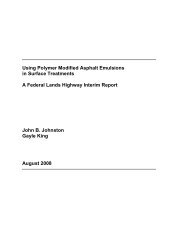Handbook for Bridge Inspections - TSP2
Handbook for Bridge Inspections - TSP2
Handbook for Bridge Inspections - TSP2
Create successful ePaper yourself
Turn your PDF publications into a flip-book with our unique Google optimized e-Paper software.
load Bearing Cables<br />
• Broken strands. A cable is most subject to broken strands around<br />
the clamps, saddles and anchorage caps. Broken strands can be<br />
identified by longitudinal cracks in the painted surface along the<br />
edges of the broken strands. New brea ks should be marked on<br />
the sketch by specifying the cable number and the approximate<br />
distance from the tower, suspension rods or similar parts.<br />
• Corrosion. Cables should be checked fo r external corrosion and<br />
signs of internal corrosion. This is especially the case with<br />
unprotected cabl es. One indication of internal corrosion can be<br />
an increase in cable diameter.<br />
• Wear and tear/chaffing. Cables are often subj ected to wear and<br />
tear or chaffing around the suspension rod clamps if the suspen<br />
sian rods are hanging out of line.<br />
• Check whether any of the spinning material has begun to leak<br />
out of the inner cable.<br />
• The condition of the surface treatment should be evaluated.<br />
• Check whether there has been any slipping between cables and<br />
their saddles.<br />
• Packing around the saddl es. Ensure that the cables are compl e<br />
tely surrounded by packing material if this has been used and<br />
that the fasteners are in good condition. The packing material<br />
should be soft and elastic and bear no signs of cracks or other<br />
damage.<br />
Figllre 6. 5- /: Broken Strands of a Cable<br />
Saddles/ Bearings of<br />
Main Cables<br />
Anchorage Caps<br />
• Loose/missing bolts, nuts or clamp plates<br />
• Movement<br />
• Cracks<br />
• Corrosion damage<br />
• Condit ion of the surface treatment<br />
• Birds' nests or other <strong>for</strong>ms of surface soiling<br />
• Check that the anchorage caps arc correctly seated on their stays<br />
and that the tangents of the cabl es fonn the correct angles.<br />
• Check whether the cement grouting in the joints betwcen cables<br />
and cable heads is still intact. The grouting should be removed<br />
from a couple of the cable heads of each anchorage. If corrosion<br />
<strong>Handbook</strong> <strong>for</strong> <strong>Bridge</strong> <strong>Inspections</strong> 75
















